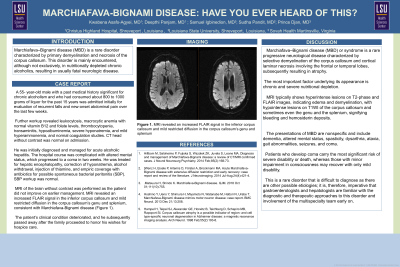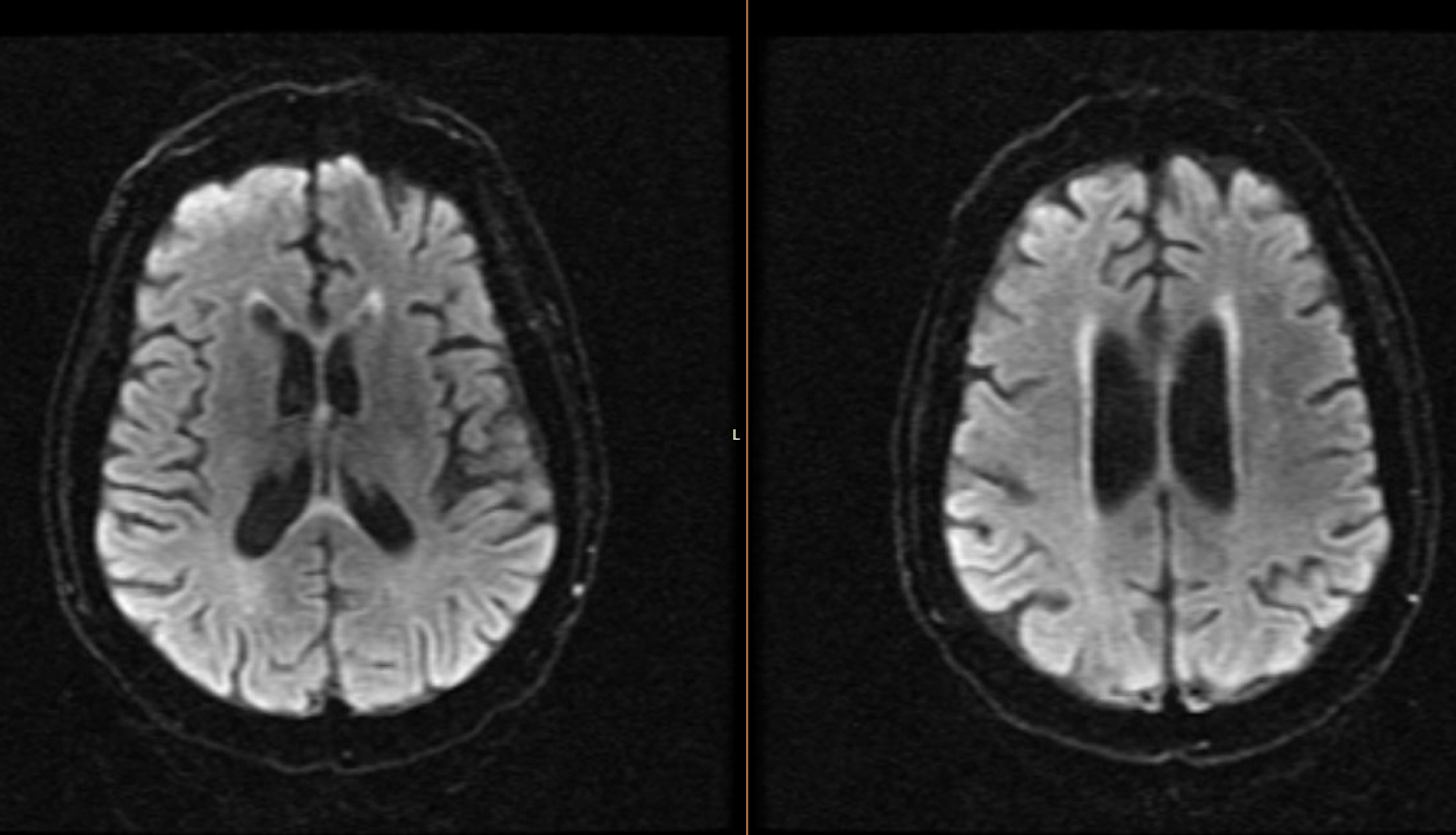Back


Poster Session A - Sunday Afternoon
Category: Liver
A0507 - Marchiafava-Bignami Disease: Have You Ever Heard of This?
Sunday, October 23, 2022
5:00 PM – 7:00 PM ET
Location: Crown Ballroom

Has Audio
- KA
Kwabena Asafo-Agyei, MD
Christus Highland Hospital
Shreveport, LA
Presenting Author(s)
Kwabena Asafo-Agyei, MD1, Deepthi Panjam, MD1, Samuel Igbinedion, MD2, Sudha Pandit, MD3, Prince Djan, MD4
1Christus Highland Hospital, Shreveport, LA; 2Louisiana State University Health Sciences Center, Shreveport, LA; 3LSUHSC, Shreveport, LA; 4Sovah Health, Martinsville, VA
Introduction: Marchiafava–Bignami disease (MBD) is a rare disorder characterized by primary demyelination and necrosis of the corpus callosum. This disorder is mainly encountered, although not exclusively, in nutritionally depleted chronic alcoholics, resulting in usually fatal neurologic disease.
Case Description/Methods: A 55- year-old male with a past medical history significant for chronic alcoholism and who had consumed about 800 to 1000 grams of liquor for the past 15 years was admitted to the inpatient service initially for evaluation of recurrent falls and new-onset abdominal pain over the last few weeks. Further workup revealed leukocytosis, macrocytic anemia with normal vitamin B12 and folate levels, thrombocytopenia, transaminitis, hypoalbuminemia, severe hyponatremia, and mild hyperammonemia, and with normal coagulation studies. CT head without contrast was normal on admission. He was initially diagnosed and managed for acute alcoholic hepatitis. The hospital course was complicated with altered mental status, which progressed to a coma in two weeks. He was treated for hepatic encephalopathy, correction of hyponatremia, alcohol withdrawal, injection of thiamine, and empiric coverage with antibiotics for possible spontaneous bacterial peritonitis (SBP). SBP workup was normal, as well as other neurologic disorders. MRI of the brain without contrast was later performed as the patient did not improve on earlier management. MRI revealed an increased FLAIR signal in the inferior corpus callosum and mild restricted diffusion in the genu and splenium of the corpus callosum consistent with Marchiafava-Bignami disease. The patient’s clinical condition deteriorated, and he passed away subsequently after the family proceeded to honor his wishes for hospice care.
Discussion: MBD mainly involves the corpus callosum but can affect other brain regions. The presentations of MBD are nonspecific and include dementia, altered mental status, spasticity, dysarthria, ataxia, gait abnormalities, seizures, and coma. MBD manifesting with severe neurological dysfunction has a poorer prognosis. This is a rare disorder that is not only difficult to diagnose as there are other possible etiologies; it is, therefore, imperative that gastroenterologists and hepatologists are familiar with the diagnostic and therapeutic approaches to this disorder and involvement of the multispecialty team early on.

Disclosures:
Kwabena Asafo-Agyei, MD1, Deepthi Panjam, MD1, Samuel Igbinedion, MD2, Sudha Pandit, MD3, Prince Djan, MD4. A0507 - Marchiafava-Bignami Disease: Have You Ever Heard of This?, ACG 2022 Annual Scientific Meeting Abstracts. Charlotte, NC: American College of Gastroenterology.
1Christus Highland Hospital, Shreveport, LA; 2Louisiana State University Health Sciences Center, Shreveport, LA; 3LSUHSC, Shreveport, LA; 4Sovah Health, Martinsville, VA
Introduction: Marchiafava–Bignami disease (MBD) is a rare disorder characterized by primary demyelination and necrosis of the corpus callosum. This disorder is mainly encountered, although not exclusively, in nutritionally depleted chronic alcoholics, resulting in usually fatal neurologic disease.
Case Description/Methods: A 55- year-old male with a past medical history significant for chronic alcoholism and who had consumed about 800 to 1000 grams of liquor for the past 15 years was admitted to the inpatient service initially for evaluation of recurrent falls and new-onset abdominal pain over the last few weeks. Further workup revealed leukocytosis, macrocytic anemia with normal vitamin B12 and folate levels, thrombocytopenia, transaminitis, hypoalbuminemia, severe hyponatremia, and mild hyperammonemia, and with normal coagulation studies. CT head without contrast was normal on admission. He was initially diagnosed and managed for acute alcoholic hepatitis. The hospital course was complicated with altered mental status, which progressed to a coma in two weeks. He was treated for hepatic encephalopathy, correction of hyponatremia, alcohol withdrawal, injection of thiamine, and empiric coverage with antibiotics for possible spontaneous bacterial peritonitis (SBP). SBP workup was normal, as well as other neurologic disorders. MRI of the brain without contrast was later performed as the patient did not improve on earlier management. MRI revealed an increased FLAIR signal in the inferior corpus callosum and mild restricted diffusion in the genu and splenium of the corpus callosum consistent with Marchiafava-Bignami disease. The patient’s clinical condition deteriorated, and he passed away subsequently after the family proceeded to honor his wishes for hospice care.
Discussion: MBD mainly involves the corpus callosum but can affect other brain regions. The presentations of MBD are nonspecific and include dementia, altered mental status, spasticity, dysarthria, ataxia, gait abnormalities, seizures, and coma. MBD manifesting with severe neurological dysfunction has a poorer prognosis. This is a rare disorder that is not only difficult to diagnose as there are other possible etiologies; it is, therefore, imperative that gastroenterologists and hepatologists are familiar with the diagnostic and therapeutic approaches to this disorder and involvement of the multispecialty team early on.

Figure: Figure 1. MRI WITH AND WITHOUT CONTRAST OF THE BRAIN
Disclosures:
Kwabena Asafo-Agyei indicated no relevant financial relationships.
Deepthi Panjam indicated no relevant financial relationships.
Samuel Igbinedion indicated no relevant financial relationships.
Sudha Pandit indicated no relevant financial relationships.
Prince Djan indicated no relevant financial relationships.
Kwabena Asafo-Agyei, MD1, Deepthi Panjam, MD1, Samuel Igbinedion, MD2, Sudha Pandit, MD3, Prince Djan, MD4. A0507 - Marchiafava-Bignami Disease: Have You Ever Heard of This?, ACG 2022 Annual Scientific Meeting Abstracts. Charlotte, NC: American College of Gastroenterology.
